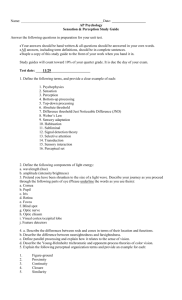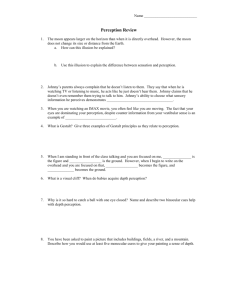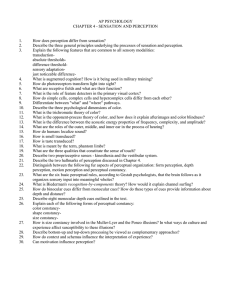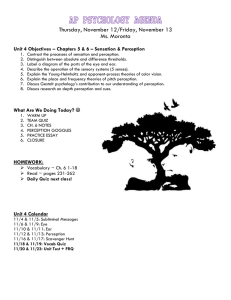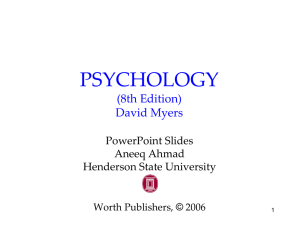Selective Attention
advertisement
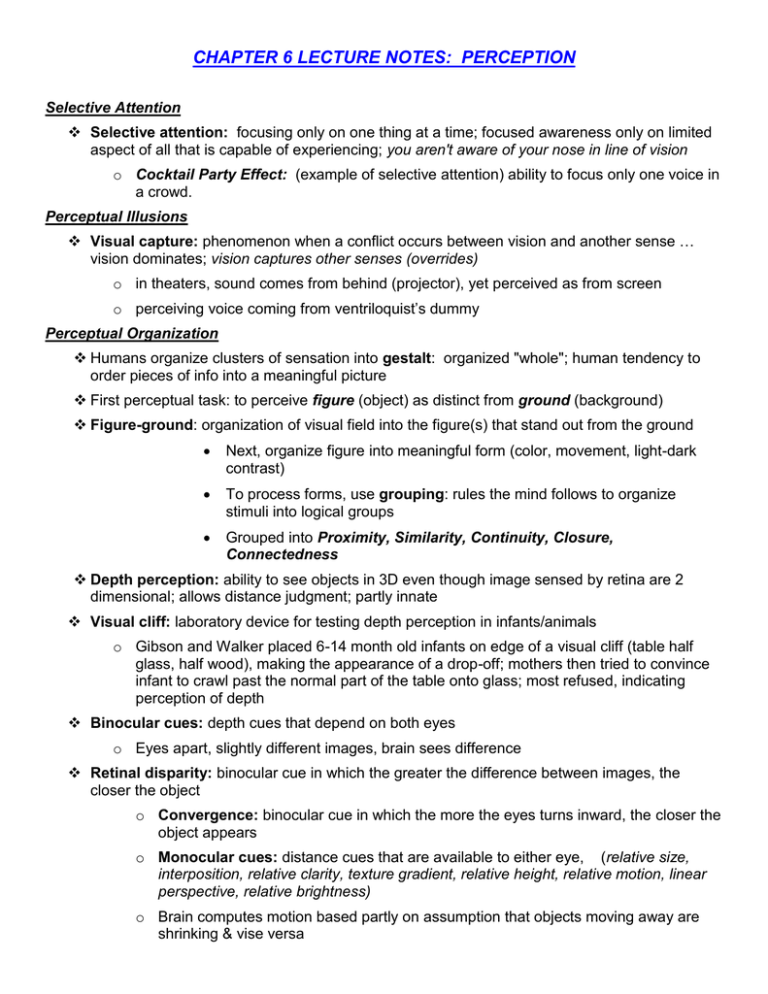
CHAPTER 6 LECTURE NOTES: PERCEPTION Selective Attention Selective attention: focusing only on one thing at a time; focused awareness only on limited aspect of all that is capable of experiencing; you aren't aware of your nose in line of vision o Cocktail Party Effect: (example of selective attention) ability to focus only one voice in a crowd. Perceptual Illusions Visual capture: phenomenon when a conflict occurs between vision and another sense … vision dominates; vision captures other senses (overrides) o in theaters, sound comes from behind (projector), yet perceived as from screen o perceiving voice coming from ventriloquist’s dummy Perceptual Organization Humans organize clusters of sensation into gestalt: organized "whole"; human tendency to order pieces of info into a meaningful picture First perceptual task: to perceive figure (object) as distinct from ground (background) Figure-ground: organization of visual field into the figure(s) that stand out from the ground Next, organize figure into meaningful form (color, movement, light-dark contrast) To process forms, use grouping: rules the mind follows to organize stimuli into logical groups Grouped into Proximity, Similarity, Continuity, Closure, Connectedness Depth perception: ability to see objects in 3D even though image sensed by retina are 2 dimensional; allows distance judgment; partly innate Visual cliff: laboratory device for testing depth perception in infants/animals o Gibson and Walker placed 6-14 month old infants on edge of a visual cliff (table half glass, half wood), making the appearance of a drop-off; mothers then tried to convince infant to crawl past the normal part of the table onto glass; most refused, indicating perception of depth Binocular cues: depth cues that depend on both eyes o Eyes apart, slightly different images, brain sees difference Retinal disparity: binocular cue in which the greater the difference between images, the closer the object o Convergence: binocular cue in which the more the eyes turns inward, the closer the object appears o Monocular cues: distance cues that are available to either eye, (relative size, interposition, relative clarity, texture gradient, relative height, relative motion, linear perspective, relative brightness) o Brain computes motion based partly on assumption that objects moving away are shrinking & vise versa o Brain reads rapid series of slightly different images as movement; phenomenon called stroboscopic movement . Another illusion of movement is phi phenomenon: perception of movement when lights blink one after the other; (the lighted arrow signs on the back of parked construction trucks) Perceptual constancy: perception that objects are not changing even under different lighting; allowing identification regardless of angle of view; (a door is a door even at 45 degree (shape constancy) angle or 20 feet away (size constancy)) Interpretation Previously blind patients often can't recognize objects familiar by touch only Sensory restriction like allowing only diffuse, unpatterned light through; affects only at infancy, suggesting critical period for development Perceptual adaptation: ability for our vision to adjust to artificial displacement; given goggles that shift vision 30 degrees to left, humans learn to adjust actions 30 degrees to left (remember the quarterback) Roger Sperry surgically turned eyes of animals; found out fish, frogs, salamanders (Note: reptiles) CAN'T ADJUST while kittens, monkeys, and humans (Note: mammals) did ADAPT Experiences, assumptions, and expectations give us a Perceptual set: mental set-up to perceive one thing and not another; ufo-looking objects that are really clouds; because we can't resist finding a pattern on unpatterned stimuli Much of our perception comes not just from world "out there", but also from behind the eyes and between the ears. ESP 50% of Americans believe in extrasensory perception (ESP): claim perception occurring without sensory input o Three varieties of ESP: Telepathy (sensing or reading thoughts), o Clairvoyance (perceiving an event unfolding), o Precognition (seeing future) Parapsychology: study of paranormal phenomena (profession called Parapsychologists) Vague predictions can later be interpreted to match events; Nostradamus claimed his prophecies could not be interpreted till after the event After many experiments, there has never been a reproducible ESP phenomenon or individual who can convincingly demonstrate psychic ability




